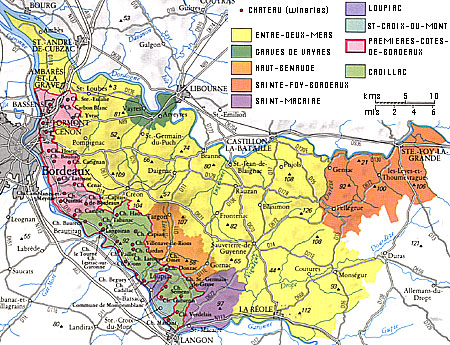
WineRegionsOld WorldFranceBordeaux
Entre-Deux-Mers (between two seas) is situated between the Dordogne and Garonne rivers. It is Bordeaux's largest district, and produces dry white wines of modest but rapidly improving quality, plus an increasing volume of red wines entitled to the Bordeaux or Bordeaux Superieur appellation. It is a long time since this district was infamous for its own sulfured, tired and flabby, semi-sweet white wine that used to catch the hack of the throat and cause the eves to water Indeed that sort of unforgiveable product persisted in the more respectable Graves district far longer than it did in Entre-Deux-Mers. Although the regulations were changed in 1977 to prohibit anything other than dry white wines for this appellation, this did not mean that the consumer was protected from unpalatable wines; the bureaucrats merely acknowledged what was happening in this large wine making district and tailored the law to fit. As early as the 1950s and 1960s there was a grass-roots viticultural movement to drop the traditional vine-training systems and adopt the revolutionary "high-culture" system. This was followed by a widespread adoption of cool-fermentation techniques in the 1970s. With fresh, light and attractively dry white wines being made at many chateaux, the major export markets suddenly realized it would be easier to sell Entre-Deux-Mers than what had become boring Bordeaux blanc, particularly if the wine could boast some sort of individual petit chateau personality.

THE "HIGH-CULTURE" SYSTEM
Entre-Deux-Mers in the late 1940s and early 1950s was a sorry place. the
wines were sold in bulk, ending up as anonymous Bordeaux blanc and much
of the decline in the Bordeaux region was centered on the district. But
the new post war generation of wine growers were not content with this state
of affairs. Although times were difficult and the economy was deteriorating,
the young, technically minded vignerons, realized that the district's
compressed boulbenes soil, which was choking the wines, could not be worked
by their fathers old methods and they therefore took a considerable financial
risk to rectify the situation. They grubbed up every other row of vines,
thus increasing the spacing between the rows, and trained the plants on
a "high-culture" system similar to that practised in Madiran and
Jurancon further south (also in Austria where it was originally conceived
and called the Lenz Moser system). This allowed machinery to work the land
and break up the soil. It also increased the canopy of foliage, intensifying
chlorophyll assimilation and improving ripening.
COOL FERMENTATION
In the 1970s university trained personnel at the well funded Entre-Deux-Mers
cooperatives invested in temperature controlled stainless-steel vats and
led the way in cool-fermentation techniques. Prior to this, fermentation
temperatures were often in excess of 28°C (83°F), but it was soon
discovered that the lower the temperature, the more aromatic compounds were
released. They found out that fermentation can take place at temperatures
as low as 4°C (39°F), but the risk of stuck fermentation was high.
It soon became clear that the ideal fermentation temperature, reckoned to
be somewhere between 10°C (50°F) and 18°C (64°F) (only
recently has it been confirmed that 18°C (64°F) is the optimum),
increased the yield of alcohol and important aromatic and flavor compounds.
It also reduced both the loss of carbonic gas and the presence of volatile
acidity and required less sulfur dioxide.